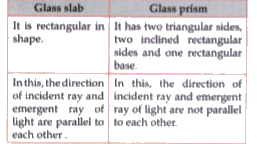Differentiate between a glass slab and a glass prism. What happens when a narrow beam of (i) a monochromatic light, and (ii) white light passes through (a) glass slab and (b) glass prism?

When a narrow beam of monochromatic light passes through
(a) Glass slab : It has deviated from the actual path but the direction of the incident ray and the emergent ray are parallel to each other
(b) Glass of sprism : It has deviated from the actual path but the direction of the incident ray and the emergent ray are not parallel to each other
When a narrow beam of white light passes through
(a) Glass slab, it does nto split into it constituent colour. The direction of incident ray and emergent ray of light are parallel to each other
(b) Glass prism, it splits into its constituent seven colour. The direction of incident ray and emergent ray of light are not parallel to each other .
Similar Questions
Knowledge Check
When white light passes through a glass prism
Ared coloured ray undergoes maximum deviation.Bgreen coloured ray undergoes minimum deviation.Cblue coloured ray undergoes minimum deviation.Dviolet coloured ray undergoes maximum deviation.White light is incident normally on a glass slab. Inside the glass slab,
Ared light travels faster than other coloursBviolet light travels faster than other coloursCyellow light travels faster than other coloursDall colours travels with the same speed.White light is incident normally on a glass slab. Inside the glass slab,
Ared light travels faster than other coloursBviolet light travels faster than other coloursCyellow light travels faster than other coloursDall colours travels with the same speed.
When a ray of light passes through glass slab, refraction of light occurs___
View Solution(a) With the help of labelled ray diagram show the path followed by a narrow beam of monochromatic light when it passes through a glass prism.
(b) What would happen if this beam is replaced by a narrow beam of white light?
View SolutionWhat happens when a beam of sunlight is passed through a glass prism ? What is spectrum ?
View Solution(a) What is dispersion of white light? What is the cause of dispersion? Draw a diagram to show the dispersion of white light by a glass prism.
(b) A glass prism is able to produce a spectrum when white light passes through it but a glass slab does not produce any spectrum. Explain why it is so.
View SolutionWhen a beam of white light passes through a glass prism,
the colour of light beam that deviates the least is
View Solution
